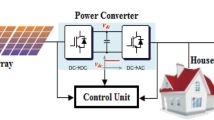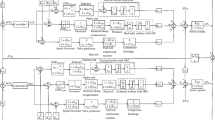Abstract
Dynamic frequency stability concerns are engendered in the modern electric power system due to the large penetration of low inertia inverter interfaced distributed generation (IIDG) into the utility grid. Therefore, inertial support is needed similar to the conventional synchronous generator. From recent studies, it was observed that frequency stability is considered as one of the major challenges for the system operators and is required to be alleviated. In this methodology, the virtual inertia (VI) concept is suggested as a promising solution to boost the inertial response of IIDG. Full state feedback through a robust linear quadratic regulator (LQR) is employed to find optimal inertia and damping coefficients to emulate VI in IIDG. These coefficients are used to evaluate the additional power required to provide inertia emulation by a virtual synchronous generator (VSG). To upgrade the performance index in LQR, a bacterial foraging optimization algorithm (BFOA) is suggested for optimal parameters (weights) selection in the problem search space. The proposed optimal controller ameliorates VI dynamics and brings system frequency faster to the nominal value and allows more penetration of IIDGs. Time-domain simulated results and observed test system eigenvalues corroborate the effectiveness of a proposed controller. Time-domain simulations have been obtained using MATLAB/Sim Power Systems toolbox, and the LINMOD function in MATLAB is used to linearize the suggested system.












Similar content being viewed by others
Abbreviations
- IIDG:
-
Inverter interfaced distributed generation
- VI:
-
Virtual inertia
- LQR:
-
Linear quadratic regulator
- VSG:
-
Virtual synchronous generator
- BFOA:
-
Bacteria foraging optimization algorithm
- SG:
-
Synchronous generator
- SM:
-
Synchronous machine
- PMSG:
-
Permanent magnet SG
- DFIG:
-
Doubly fed induction generator
- ESS:
-
Energy storage system
- RoCoF:
-
Rate of change of frequency
- ETAP:
-
Electrical transient analyzer program
- K.E:
-
Kinetic energy
- C.P:
-
Constant parameter
- PI:
-
Performance index
- PLL:
-
Phase-locked loop
- SRF:
-
Synchronous rotating frame
- VSI:
-
Voltage source inverter
- CC:
-
Current control
- RAE:
-
Riccati algebraic equation
- i L :
-
Inverter output current
- v g :
-
Grid voltage
- u s :
-
Inverter output voltage
- iLd , iLq :
-
Inverter current in d-q frame of reference
- i* Ld , i* Lq :
-
Reference currents
- P m :
-
Mechanical input power
- P e :
-
Electrical output power
- f :
-
Measured frequency
- fnom :
-
Nominal frequency
- H e :
-
Equivalent inertia
- J :
-
Moment of inertia
- S b :
-
Base MVA
- H SG :
-
SG inertia
- SSG :
-
SG maximum capacity
- W SG :
-
SG stored K.E
- W KE :
-
Emulated K. E
- H IIDG :
-
IIDG equivalent inertia
- V DC :
-
DC link voltage
- S IIDG :
-
IIDG rated capacity
- ΔP IIDG :
-
Additional emulated active power
- M :
-
Virtual inertia coefficient
- D :
-
Virtual damping coefficient
- Q :
-
Performance weight function
- R :
-
Actuator weight function
- ΔE :
-
Change in K.E
- ΔV DC :
-
Change in dc link voltage
- K p , K i :
-
Proportional and integral gain
- J PI :
-
Cost function
- ΔP L :
-
Sudden load change
- pu :
-
Per unit
- ω :
-
Measured angular frequency
References
Poolla, B.K.; Grob, D.; Dorfler, F.: Placement and implementation of grid-forming and grid-following virtual inertia and fast frequency response. IEEE Trans. Power Syst. 34(4), 3035–3046 (2019)
Bonfiglio, A.; Invernizzi, M.; Labella, A.; Procopio, R.: Design and implementation of a variable synthetic inertia controller for wind turbine generators. IEEE Trans. Power Syst. 34(1), 754–764 (2019)
Zhong, Q.; Weiss, G.: Synchronverters: Inverters That Mimic Synchronous Generators. IEEE Trans. Industr. Electron. 58(4), 1259–1267 (2011)
Mullane, A.; O’Malley, M.: The inertial response of induction machine-based wind turbines. IEEE Trans. power syst. 20(3), 1496–1503 (2005)
Lalor, G.; Mullane, A.; O’Malley, M.: Frequency control and wind turbine technologies. IEEE Trans. Power Syst. 20(4), 1905–1913 (2005)
Keung, P.-K.; Li, P.; Banakar, H.; Ooi, B.T.: Kinetic energy of wind turbine generators for system frequency support. IEEE Trans. Power Syst. 24(1), 279–287 (2009)
Rocabert, J.; Luna, A.; Blaabjerg, F.; Rodriguez, P.: Control of power converters in ac microgrids. IEEE Trans. Power Electron. 27(11), 4734–4749 (2012)
Alipoor, J.; Miura, Y.; Ise, T.: “Power system stabilization using a virtual synchronous generator with alternating moments of inertia”, IEEE. J. Emerg. Sel. Topics Power Electron. 3(2), 451–458 (2015)
Ravanji, M.H.; Parniani, M.: Modified virtual inertial controller for prudential participation of DFIG-based wind turbines in power system frequency regulation. IET Renewable Power Gener. 13(1), 155–164 (2017)
Kang, M.; Kim, K.; Muljadi, E.; Park, J.; Kang, Y.C.: Frequency control support of a doubly-fed induction generator based on the torque limit. IEEE Trans. Power Syst. 31(6), 4575–4583 (2016)
Jinsik, L.; Jang, G.; Muljadi, E.; Blaabjerg, F.; Chen, Z.; Cheol Kang, Y.: Stable short-term frequency support using adaptive gains for a DFIG based wind power plant. IEEE Trans. Energy Convers. 31(3), 6289–6297 (2016)
Laijun, C.; Ren, W.; Tianwen, Z.: Optimal control of transient response of virtual synchronous generator based on parameter adaptive regulation. Proc. CSEE 36(21), 5724–5731 (2016)
Alipoor, J.; Miura, Y.; and Ise T.: “Distributed generation grid integration using virtual synchronous generator with adoptive virtual inertia,” In: Proc. IEEE Energy Convers. Congr. Expo., Denver, CO, USA, 2013, pp. 4546–4552.
L. F. Ochoa and G. P. Harrison, “Minimizing energy losses: Optimal accommodation and smart operation of renewable distributed generation,” In: Proc. IEEE Power Energy Soc. General Meeting, San Diego, CA, USA, 2011, pp. 24–29.
Wang, F.; Zhang, L.; Feng, X.; Guo, H.: An adaptive control strategy for virtual synchronous generator. IEEE Trans. Ind. Appl. 54(5), 5124–5133 (2018)
Markovic, U.; Chu, Z.; Aristidou, P.; Hug-Glanzmann, G.: Lqr-based adaptive virtual synchronous machine for power systems with high inverter penetration. IEEE Trans. Sust. Energy 10(3), 1501–1512 (2018)
Li, D.; Zhu, Q.; Lin, S.; Bian, X.: A self-adaptive inertia and damping combination control of VSG to support frequency stability. IEEE Trans. Energy Convers. 32(1), 397–398 (2017)
Torres, M.A.; Lopes, L.A.C.; Moran, L.A.; Espinoza, J.R.: Self-tuning virtual synchronous machine: a control strategy for energy storage systems to support dynamic frequency control. IEEE Trans Energy Convers 29(4), 833–840 (2014)
Zhang, S.; Mishra, Y.; Shahidehpour, M.: Fuzzy-logic based frequency controller for wind farms augmented with energy storage systems. IEEE Trans. Power Syst. 31(2), 1595–1603 (2015)
Li, M.; Huang, W.; Tai, N.; Yang, L.; Duan, D.; Ma, Z.: A dual-adaptivity inertia control strategy for virtual synchronous generator. IEEE Trans. On Power syst. 35(1), 594–604 (2020)
Khazaei J.; Tu Z.; Liu W.: Small-Signal Modeling and Analysis of Virtual Inertia-based PV Systems. In: IEEE Transactions on Energy Conversion
Moreno, V.M.; Liserre, M.; Pigazo, A.; Aquila, A.: A compararative analysis of real-time algorithm for power signal decomposition in multiple synchronous reference frame. IEEE Trans. Power Electron. 22(4), 1280–1289 (2007)
Kazmierkowski, M.; Krishnan, R.; Blaabjerg, F.: Control in Power Electronics—Selected Problems. Academic Press (2002)
Abdul-Ghaffar, H.I.; Ebrahim, E.A.; Azzam, M.: Design of PID controller for power system stabilization using hybrid particle swarm-bacteria foraging optimization. WSEAS Trans. Power Syst. 8(1), 12–23 (2013)
Kumar, R., Singh, R., Ashfaq, H.: Stability enhancement of induction generator–based series compensated wind power plants by alleviating sub-synchronous torsional oscillations using BFOA-optimal controller tuned STATCOM. Wind Energy. 23(9), 1846–1867 (2020)
Kumar R.; Singh R.; Ashfaq H.; Singh S.; Badoni M. “Power system stability enhancement by damping and control of Sub-synchronous torsional oscillations using Whale optimization algorithm-based Type-2 wind turbines,” ISA Transactions, 2020.
Zhu, J.; Booth, C.D.; Adam, G.P.; Roscoe, A.J.; Bright, C.G.: Inertia emulation control strategy for VSC-HVDC transmission systems. IEEE Trans. Power Syst. 28(2), 1277–1287 (2013)
C. Klumpner; M. Liserre and F. Blaabjerg, "Improved control of an active-front-end adjustable speed drive with a small de-link capacitor under real grid conditions," In: 2004 IEEE 35th Annual Power Electronics Specialists Conference (IEEE Cat. No.04CH37551), 2004.
Kumar, R.; Singh, R.; Ashfaq, H.: Stability enhancement of multi-machine power systems using Ant colony optimization-based static Synchronous Compensator. Comp. Electr Eng. 83, 106589 (2020)
Kumar, R.; Singh, R.; Ashfaq, H.: A Nature-Inspired Metaheuristic Swarm Based Optimization Technique BFOA Based Optimal Controller for Damping of SSR. Intelligent Computing Techniques for Smart Energy Systems. Lecture Notes in Electrical Engineering, Vol. 607, p. 631–639. Springer, Singapore (2020)
Kumar, R.; Diwania, S.; Singh, R.; Ashfaq, H.; Khetrapal, P.; Singh, S.: An intelligent Hybrid Wind–PV farm as a static compensator for overall stability and control of multimachine power system. ISA Trans. (2021). https://doi.org/10.1016/j.isatra.2021.05.014
Author information
Authors and Affiliations
Corresponding authors
Rights and permissions
About this article
Cite this article
Singh, S.K., Singh, R., Ashfaq, H. et al. Virtual Inertia Emulation of Inverter Interfaced Distributed Generation (IIDG) for Dynamic Frequency Stability & Damping Enhancement Through BFOA Tuned Optimal Controller. Arab J Sci Eng 47, 3293–3310 (2022). https://doi.org/10.1007/s13369-021-06121-5
Received:
Accepted:
Published:
Issue Date:
DOI: https://doi.org/10.1007/s13369-021-06121-5




